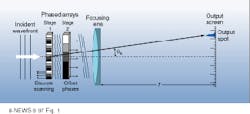A programmable, multichannel array of phase modulators based on lanthanum-modified lead zirconate titanate (PLZT) performs continuous beam steering with submicrosecond switching speeds. Developed by James Thomas and fellow researchers at the University of California, San Diego (UCSD), the array induces a phase retardation across the wavefront that is analogous to the effect of a diffractive optic. The technology has applications in two- and three-dimensional laser displays, laser communications, and lidar.
A voltage applied to PLZT induces a refractive-index change through the electro-optical effect. Electrodes applied to a wafer of the material create an array of independently addressable modulators that can be programmed such that the array acts as a diffractive optical phase grating, applying an arbitrary phase retardation across an incident beam. Lanthanum-modified lead zirconate titanate offers a large quadratic electro-optical coefficient with comparatively small linear effects. It is suitable for use at visible and infrared wavelengths. Moreover, the ceramic can be economically produced in large volume.
The researchers applied an array of electrodes to a 350-µm-thick wafer of PLZT using vacuum-evaporated chrome gold and lithographic techniques. The 0.75-in.-square flatpack mounting incorporates a 12.8 × 10.0-mm aperture that allows the device to be used in transmission mode. The modulator spacing is 400 µm, and each element has a 40-µm clear aperture.
Cascaded arrays
High-resolution arrays require large numbers of electrodes, or control lines. To achieve high resolution in a system with reasonable size, cost, and power requirements, the group approximated the performance by cascading two lower-resolution arrays.
Other cascaded systems use both arrays to mimic blazed gratings, applying a coarse/fine protocol--the first array deflects the beam to one of a number of broadly spaced angles, while the second array performs fine angular adjustment. Although the coarse/fine protocol approximates a high-resolution scanner with relatively low-resolution arrays, it induces excessive losses and noise in the form of phase errors that diffract light into the scan zone.
New protocol
A discrete/offset-bias protocol developed by the UCSD team skirts these drawbacks by cascading an initial element capable of discrete angular deflection with a second stage that provides continuous angle tuning. Like the coarse/fine system, the first stage in the UCSD system acts as a blazed grating, which by itself would only be capable of deflecting the incident beam to one of a series of discrete angles. In the discrete/offset-bias protocol, however, this stage is programmed to deflect the beam directly to the desired angle, which has the effect of sectioning the wavefront into tilted segments (see Fig. 1).
If the deflection angle is not ml/d—as is the case for the diffractive optic approximating a blazed grating—the wavefront segments will destructively interfere in the far field. To eliminate this behavior, the second array introduces a spatially modulated, stepped phase retardation to the emerging wavefront so that the segments join to produce a continuous wavefront.
In experiments, the group steered a HeNe laser beam to 32 separate scan positions. The researchers programmed the device using coarse/fine protocol and then using discrete/offset bias protocol. Results from the coarse/fine-protocol test show errors induced by the technique (see Fig. 2). The discrete/offset-bias protocol demonstrated accurate deflection with higher overall diffraction efficiency.The current device has a 10% fill factor, causing an immediate loss of 90% of the incident light. The group is fabricating a set of diffractive lenslet arrays to focus light into the clear apertures of current devices, enhancing the effective fill factor.
Next-generation devices will consist of two wafers of PLZT sandwiching an indium tin oxide ground plane to produce a two-stage, single-substrate array. Future work will focus on reducing the size of the individual modulators to increase resolution, dropping operating voltages to less than 100 V, and improving electrode geometries.
The work was sponsored by the Naval Research and Development Laboratory (San Diego, CA) and was presented at the SPIE Annual Meeting (San Diego, CA; paper #3131-13).
About the Author
Kristin Lewotsky
Associate Editor (1994-1997)
Kristin Lewotsky was an associate editor for Laser Focus World from December 1994 through November 1997.

